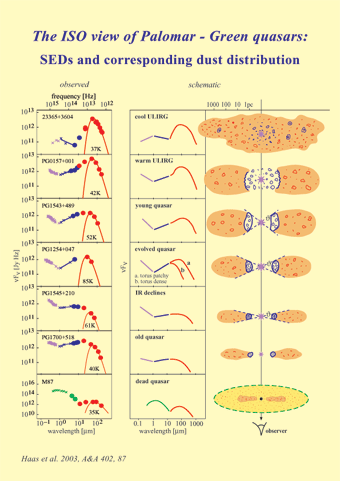 |
|
||||||||||||||||||
|
Evolution of dust
emission in quasars
|
 |
Based on the
sensitive ISO data now we do not only see the coarse IR differences
between ULIRGs and quasars known from earlier IRAS studies (Sanders et
al., ApJ 325, 74, 1988), but also the details and a possible evolution
of the dust distribution and emission even among the optically selected
Palomar-Green quasar sample.During such an evolution (from top to
bottom) the dust distribution rearranges, settling more and more into a
torus/disk like configuration. The corresponding SEDs show an initial
FIR bump (red coloured) for the young quasars, then an increase in MIR
emission and a steepening of the infrared slope between 1 and 15
µm (blue coloured) for the evolved quasars, both of which finally
also decrease for the old quasars. During the evolution the AGN
strength grows, then stays high and finally declines, as is marked by
the size of the star and shows up in the SEDs by the optical slope
(violett coloured). As a relict a "dead quasar" remains with a starved
black hole sitting in a bright host galaxy (green coloured). In this evolutionary scheme, our PG quasars essentally populate the classes 2 and 3, and some even the late phase 4, whereby we choose the terminology young - evolved - old with respect to the dust signatures. The interpretation of the SED classes as part of an evolutionary sequence provides a new issue and it will have to be investigated, how far every quasar of class 2 needs to evolve along all the steps of the sequence up to class 4. Nevertheless, going the other way round and considering a quasar of a given SED class, a quasar of say class 3b does not exist ad hoc, rather when asking ``what was the precursor of this object type?'', a plausible candidate is one like class 3a in the proposed scheme. Moreover, in the picture of quasars as merger remnants, the amount and distribution of dust could also depend on the parent galaxies or distortions of an evolved quasar by a second merger event with a dust-rich galaxy, leading to deviations from simple straight forward expectations like in the proposed scheme. Further reading: Haas M., Klaas U., Müller S., et al., 2003, A&A 402, 87 |
||||